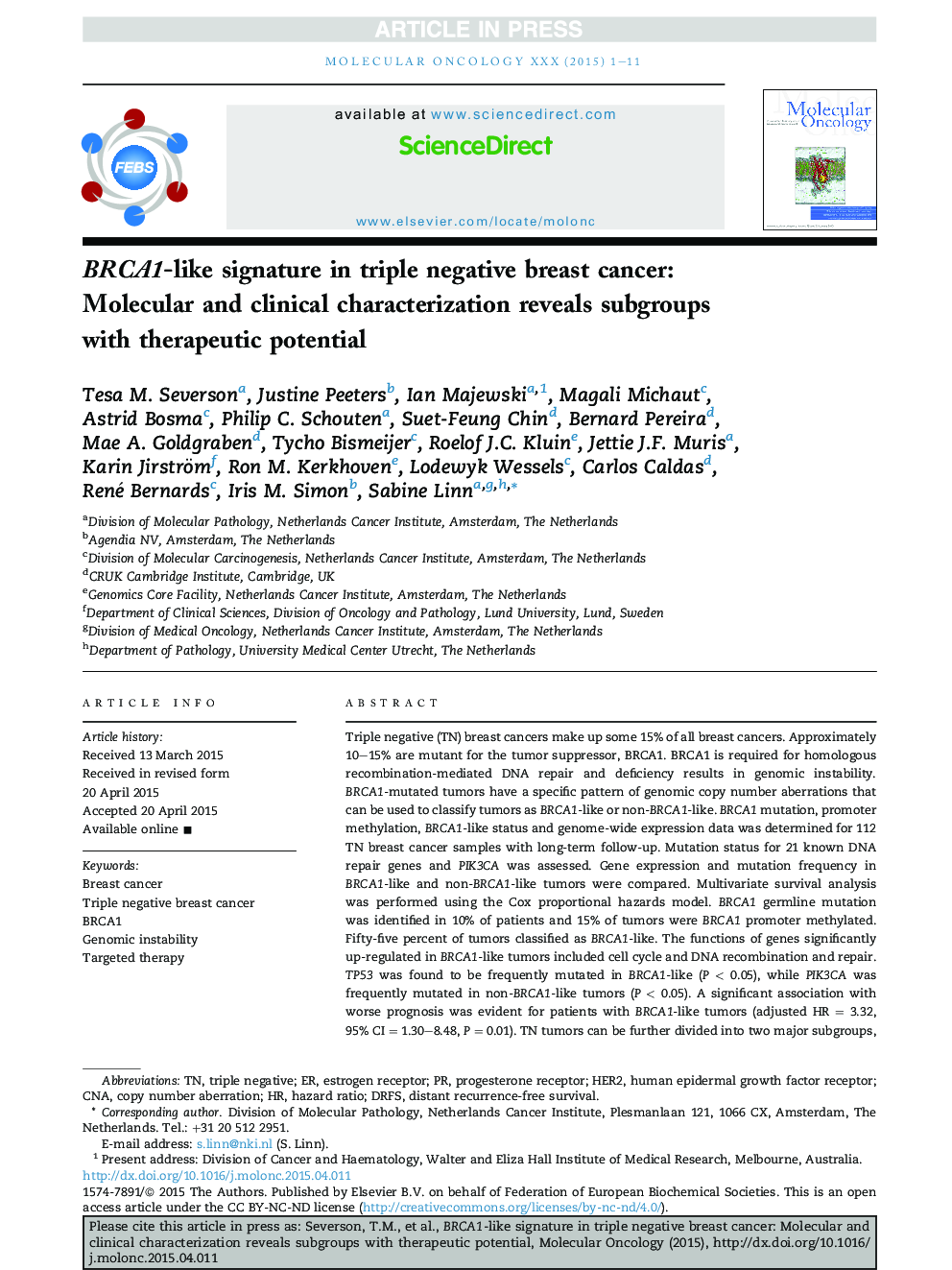| کد مقاله | کد نشریه | سال انتشار | مقاله انگلیسی | نسخه تمام متن |
|---|---|---|---|---|
| 10914698 | 1088807 | 2015 | 11 صفحه PDF | دانلود رایگان |
عنوان انگلیسی مقاله ISI
BRCA1-like signature in triple negative breast cancer: Molecular and clinical characterization reveals subgroups with therapeutic potential
دانلود مقاله + سفارش ترجمه
دانلود مقاله ISI انگلیسی
رایگان برای ایرانیان
کلمات کلیدی
HER2CNAGenomic instability - بی ثباتی ژنوم Targeted therapy - درمان هدفمندTriple negative breast cancer - سرطان سینه سه گانه منفیBreast cancer - سرطان پستانTriple negative - سه گانه منفیhazard ratio - نسبت خطرBRCA1 - ژن BRCA1copy number aberration - کپی شماره ابهامEstrogen receptor - گیرنده استروژنhuman epidermal growth factor receptor - گیرنده عامل فاکتور رشد اپیدرمی انسانProgesterone receptor - گیرنده پروژسترون
موضوعات مرتبط
علوم زیستی و بیوفناوری
بیوشیمی، ژنتیک و زیست شناسی مولکولی
تحقیقات سرطان
پیش نمایش صفحه اول مقاله

چکیده انگلیسی
Triple negative (TN) breast cancers make up some 15% of all breast cancers. Approximately 10-15% are mutant for the tumor suppressor, BRCA1. BRCA1 is required for homologous recombination-mediated DNA repair and deficiency results in genomic instability. BRCA1-mutated tumors have a specific pattern of genomic copy number aberrations that can be used to classify tumors as BRCA1-like or non-BRCA1-like. BRCA1 mutation, promoter methylation, BRCA1-like status and genome-wide expression data was determined for 112 TN breast cancer samples with long-term follow-up. Mutation status for 21 known DNA repair genes and PIK3CA was assessed. Gene expression and mutation frequency in BRCA1-like and non-BRCA1-like tumors were compared. Multivariate survival analysis was performed using the Cox proportional hazards model. BRCA1 germline mutation was identified in 10% of patients and 15% of tumors were BRCA1 promoter methylated. Fifty-five percent of tumors classified as BRCA1-like. The functions of genes significantly up-regulated in BRCA1-like tumors included cell cycle and DNA recombination and repair. TP53 was found to be frequently mutated in BRCA1-like (PÂ <Â 0.05), while PIK3CA was frequently mutated in non-BRCA1-like tumors (PÂ <Â 0.05). A significant association with worse prognosis was evident for patients with BRCA1-like tumors (adjusted HRÂ =Â 3.32, 95% CIÂ =Â 1.30-8.48, PÂ =Â 0.01). TN tumors can be further divided into two major subgroups, BRCA1-like and non-BRCA1-like with different mutation and expression patterns and prognoses. Based on these molecular patterns, subgroups may be more sensitive to specific targeted agents such as PI3K or PARP inhibitors.
ناشر
Database: Elsevier - ScienceDirect (ساینس دایرکت)
Journal: Molecular Oncology - Volume 9, Issue 8, October 2015, Pages 1528-1538
Journal: Molecular Oncology - Volume 9, Issue 8, October 2015, Pages 1528-1538
نویسندگان
Tesa M. Severson, Justine Peeters, Ian Majewski, Magali Michaut, Astrid Bosma, Philip C. Schouten, Suet-Feung Chin, Bernard Pereira, Mae A. Goldgraben, Tycho Bismeijer, Roelof J.C. Kluin, Jettie J.F. Muris, Karin Jirström, Ron M. Kerkhoven,